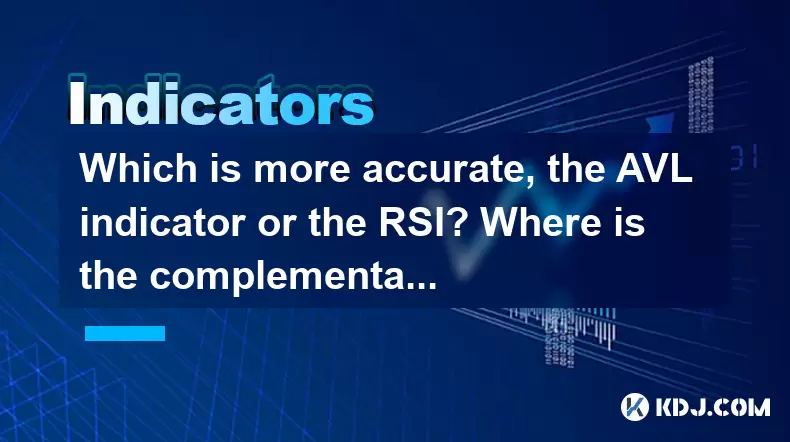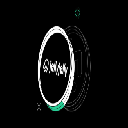-
 bitcoin
bitcoin $122090.672462 USD
1.59% -
 ethereum
ethereum $4493.758974 USD
0.56% -
 xrp
xrp $3.033145 USD
0.65% -
 tether
tether $1.000629 USD
0.00% -
 bnb
bnb $1169.854250 USD
7.07% -
 solana
solana $230.954786 USD
-0.19% -
 usd-coin
usd-coin $0.999785 USD
0.00% -
 dogecoin
dogecoin $0.256108 USD
-1.12% -
 tron
tron $0.342333 USD
-0.12% -
 cardano
cardano $0.859632 USD
-0.10% -
 hyperliquid
hyperliquid $48.932146 USD
-2.25% -
 chainlink
chainlink $22.345466 USD
-1.29% -
 ethena-usde
ethena-usde $1.000217 USD
-0.03% -
 avalanche
avalanche $31.203456 USD
1.93% -
 sui
sui $3.579145 USD
1.05%
Which is more accurate, the AVL indicator or the RSI? Where is the complementarity reflected?
AVL and RSI indicators complement each other in crypto trading, with AVL gauging trend strength via volume and RSI signaling potential reversals through momentum analysis.
May 22, 2025 at 08:28 am

In the realm of cryptocurrency trading, technical indicators play a crucial role in helping traders make informed decisions. Two popular indicators that traders often rely on are the AVL (Average Volume Line) indicator and the RSI (Relative Strength Index). Both indicators serve different purposes and provide unique insights into market trends. In this article, we will explore the accuracy of each indicator and examine how they complement each other in trading strategies.
Understanding the AVL Indicator
The AVL indicator is a volume-based technical analysis tool that helps traders understand the strength of market trends by analyzing the average volume of trades over a specific period. The AVL indicator is particularly useful in identifying potential trend reversals and confirming the strength of current trends.
To use the AVL indicator effectively, traders typically follow these steps:
- Select the appropriate timeframe: Depending on your trading strategy, you might choose a short-term or long-term timeframe.
- Add the AVL indicator to your chart: Most trading platforms allow you to add the AVL indicator to your chart with a few clicks.
- Analyze the AVL line: The AVL line represents the average volume over the selected period. A rising AVL line indicates increasing volume and potentially stronger trends, while a declining AVL line may signal weakening trends.
- Look for divergences: If the price is moving in one direction and the AVL line is moving in the opposite direction, it could indicate a potential reversal.
The accuracy of the AVL indicator lies in its ability to reflect the true market sentiment through volume analysis. By understanding the volume behind price movements, traders can make more informed decisions about the sustainability of a trend.
Understanding the RSI Indicator
The RSI indicator is a momentum oscillator that measures the speed and change of price movements. It is typically used to identify overbought or oversold conditions in the market. The RSI ranges from 0 to 100, with readings above 70 indicating overbought conditions and readings below 30 indicating oversold conditions.
To use the RSI indicator effectively, traders follow these steps:
- Add the RSI indicator to your chart: Similar to the AVL indicator, most trading platforms allow you to add the RSI with a few clicks.
- Set the RSI period: The standard period for the RSI is 14, but traders can adjust this based on their strategy.
- Monitor RSI levels: Pay attention to when the RSI crosses above 70 or below 30 to identify potential overbought or oversold conditions.
- Look for RSI divergences: Similar to the AVL, divergences between the RSI and price can signal potential reversals.
The accuracy of the RSI lies in its ability to signal when a cryptocurrency might be due for a correction or a bounce. By identifying these overbought and oversold conditions, traders can time their entries and exits more effectively.
Comparing the Accuracy of AVL and RSI
When comparing the accuracy of the AVL and RSI indicators, it's important to consider their different focuses. The AVL indicator is more accurate in gauging the strength of a trend through volume analysis, making it particularly useful for confirming the sustainability of a trend. On the other hand, the RSI indicator is more accurate in identifying potential reversals through momentum analysis, making it effective for timing entries and exits.
Both indicators have their strengths and weaknesses, and neither can be considered universally more accurate than the other. The accuracy of each indicator depends on the specific market conditions and the trader's strategy. For example, during periods of high volatility, the RSI might be more accurate in signaling potential reversals, while during periods of steady trends, the AVL might be more accurate in confirming the strength of those trends.
Complementarity of AVL and RSI
The complementarity between the AVL and RSI indicators is reflected in how they can be used together to form a more comprehensive trading strategy. By combining the volume analysis of the AVL with the momentum analysis of the RSI, traders can gain a deeper understanding of market conditions.
Here's how the complementarity can be utilized:
- Confirming trends: Use the AVL to confirm the strength of a trend, and then use the RSI to identify potential overbought or oversold conditions within that trend.
- Identifying reversals: Look for divergences between the price and the AVL, and then use the RSI to confirm potential reversals. If the RSI also shows a divergence, it strengthens the signal.
- Timing entries and exits: Use the RSI to identify overbought or oversold conditions, and then use the AVL to confirm the volume behind these conditions. If the volume supports the RSI signal, it can be a more reliable entry or exit point.
By using both indicators in tandem, traders can reduce false signals and improve the accuracy of their trading decisions. The complementarity lies in the fact that they provide different but complementary information about the market, allowing traders to make more informed and nuanced decisions.
Practical Application of AVL and RSI
To illustrate the practical application of the AVL and RSI indicators, let's consider a hypothetical trading scenario in the cryptocurrency market.
Suppose you are analyzing Bitcoin (BTC) on a daily chart. You notice that the price of BTC has been steadily increasing over the past few weeks, and you want to determine if the trend is sustainable and when to enter or exit a trade.
- Step 1: Add the AVL and RSI indicators to your chart. Ensure that both indicators are set to the appropriate periods for your strategy.
- Step 2: Analyze the AVL line. If the AVL line is rising alongside the price, it indicates strong volume supporting the uptrend, suggesting that the trend might be sustainable.
- Step 3: Monitor the RSI. If the RSI is approaching or exceeding 70, it indicates that BTC might be overbought, and a potential reversal could be imminent.
- Step 4: Look for divergences. If the price continues to rise but the AVL starts to decline, it could signal weakening volume and a potential reversal. If the RSI also shows a bearish divergence, it strengthens the case for a potential reversal.
- Step 5: Make your trading decision. If both the AVL and RSI suggest a potential reversal, you might decide to exit your long position or even enter a short position. Conversely, if the AVL confirms the strength of the trend and the RSI is not yet overbought, you might decide to hold your position or enter a new long position.
By following these steps and using the AVL and RSI indicators together, you can make more informed trading decisions based on a comprehensive analysis of both volume and momentum.
Frequently Asked Questions
Q1: Can the AVL indicator be used on its own for trading decisions?A1: While the AVL indicator can provide valuable insights into the strength of a trend, it is generally more effective when used in conjunction with other indicators like the RSI. Relying solely on the AVL might lead to missed opportunities or false signals, as it does not account for momentum or overbought/oversold conditions.
Q2: How often should I adjust the settings of the RSI and AVL indicators?A2: The settings for the RSI and AVL indicators should be adjusted based on your trading strategy and the specific market conditions. For short-term trading, you might use shorter periods, while for long-term trading, longer periods might be more appropriate. It's important to test different settings and find what works best for your strategy.
Q3: Are there other indicators that complement the AVL and RSI well?A3: Yes, other indicators that complement the AVL and RSI include the Moving Average Convergence Divergence (MACD) for trend confirmation and the Bollinger Bands for volatility analysis. Using a combination of these indicators can provide a more holistic view of the market.
Q4: How can I avoid false signals when using the AVL and RSI indicators?A4: To avoid false signals, it's important to use both the AVL and RSI indicators in conjunction with each other and look for confirmations across multiple timeframes. Additionally, consider using other technical analysis tools and fundamental analysis to validate your trading decisions.
Disclaimer:info@kdj.com
The information provided is not trading advice. kdj.com does not assume any responsibility for any investments made based on the information provided in this article. Cryptocurrencies are highly volatile and it is highly recommended that you invest with caution after thorough research!
If you believe that the content used on this website infringes your copyright, please contact us immediately (info@kdj.com) and we will delete it promptly.
- BlockDAG, DOGE, HYPE Sponsorship: Crypto Trends Shaping 2025
- 2025-10-01 00:25:13
- Deutsche Börse and Circle: A StableCoin Adoption Powerhouse in Europe
- 2025-10-01 00:25:13
- BlockDAG's Presale Buzz: Is It the Crypto to Watch in October 2025?
- 2025-10-01 00:30:13
- Bitcoin, Crypto, and IQ: When Genius Meets Digital Gold?
- 2025-10-01 00:30:13
- Stablecoins, American Innovation, and Wallet Tokens: The Next Frontier
- 2025-10-01 00:35:12
- NBU, Coins, and Crypto in Ukraine: A New Yorker's Take
- 2025-10-01 00:45:14
Related knowledge

What is a tower bottom candlestick pattern? Does it have a high success rate?
Sep 22,2025 at 07:18am
Tower Bottom Candlestick Pattern Explained1. The tower bottom candlestick pattern is a reversal formation that typically appears at the end of a downt...

What is a black hole pattern in the MACD indicator? Is it a cause for concern?
Sep 21,2025 at 06:54pm
Bitcoin's Role in Decentralized Finance1. Bitcoin remains the cornerstone of decentralized finance, serving as a benchmark for value and security acro...

How can I use the psychological line (PSY) to determine market sentiment?
Sep 17,2025 at 02:19pm
Understanding the Psychological Line (PSY) in Cryptocurrency TradingThe Psychological Line, commonly referred to as PSY, is a momentum oscillator used...

How can I determine if a double top pattern has officially formed?
Sep 21,2025 at 03:18am
Understanding the Structure of a Double Top Pattern1. A double top pattern consists of two distinct peaks that reach approximately the same price leve...

What is the Golden Valley pattern on the moving average? Is it better than the Silver Valley pattern?
Sep 21,2025 at 02:54pm
Understanding the Golden Valley Pattern in Moving Averages1. The Golden Valley pattern is a technical formation observed in cryptocurrency price chart...

What does a death cross of the RSI in the strong zone (above 50) mean?
Sep 17,2025 at 10:54pm
Understanding the Death Cross in RSI Context1. The term 'death cross' is traditionally associated with moving averages, where a short-term average cro...

What is a tower bottom candlestick pattern? Does it have a high success rate?
Sep 22,2025 at 07:18am
Tower Bottom Candlestick Pattern Explained1. The tower bottom candlestick pattern is a reversal formation that typically appears at the end of a downt...

What is a black hole pattern in the MACD indicator? Is it a cause for concern?
Sep 21,2025 at 06:54pm
Bitcoin's Role in Decentralized Finance1. Bitcoin remains the cornerstone of decentralized finance, serving as a benchmark for value and security acro...

How can I use the psychological line (PSY) to determine market sentiment?
Sep 17,2025 at 02:19pm
Understanding the Psychological Line (PSY) in Cryptocurrency TradingThe Psychological Line, commonly referred to as PSY, is a momentum oscillator used...

How can I determine if a double top pattern has officially formed?
Sep 21,2025 at 03:18am
Understanding the Structure of a Double Top Pattern1. A double top pattern consists of two distinct peaks that reach approximately the same price leve...

What is the Golden Valley pattern on the moving average? Is it better than the Silver Valley pattern?
Sep 21,2025 at 02:54pm
Understanding the Golden Valley Pattern in Moving Averages1. The Golden Valley pattern is a technical formation observed in cryptocurrency price chart...

What does a death cross of the RSI in the strong zone (above 50) mean?
Sep 17,2025 at 10:54pm
Understanding the Death Cross in RSI Context1. The term 'death cross' is traditionally associated with moving averages, where a short-term average cro...
See all articles










































































